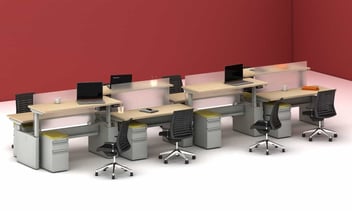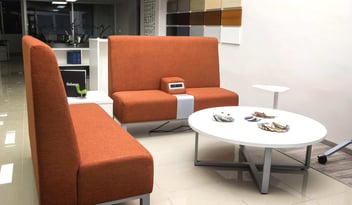Executive CEO Office Design: Why the Right Space Matters
Walk into a CEO’s office, and you’re not just stepping into another room—you’re entering the center of leadership. It’s a space where decisions are made, brands are shaped, and culture quietly takes form.
Recent research from Gensler’s Global Workplace Survey 2024 even shows that 81% of employees judge a company’s credibility based on how its leaders use their space.¹ That says a lot about how the modern office has evolved.
In today’s world, an executive workplace isn’t about having the biggest corner office or the flashiest desk. It’s about creating an environment that balances privacy and openness, embraces sustainability, and integrates technology that supports both in-person and hybrid work.

At Gebesa, decades of working with North America’s most demanding workplaces, we’ve seen how the right design can shape not just productivity—but leadership itself.
Even in the era of hybrid teams and virtual collaboration, some moments still need a physical anchor. Think of board meetings, investor briefings, or crisis conversations. These aren’t the moments you handle from a coffee shop or a home office.
The right executive space offers something rare: clarity. Ergonomic design helps the mind stay focused; sustainable materials send a signal about the values the company stands for; and an inviting yet secure atmosphere helps people—from employees to clients—feel welcome and confident. So…
What’s shaping executive offices in 2025?
The trends are clear and surprisingly human-centered:
- Flexible layouts with movable walls let leaders shift from deep solo work to quick team sessions.
- Smart technology—motorized cameras, acoustic mics—ensures everyone, even remote directors, stays connected.
- Sustainability is no longer a “nice to have”; it’s essential. We’re seeing FSC-certified woods, recycled metals, and eco-conscious finishes making their way into these spaces.
- Wellness isn’t an afterthought either—sit-stand desks, circadian lighting, and acoustic privacy help leaders stay sharp without burning out.
- Glass everywhere: There’s also a fascinating shift in transparency. Many leaders want glass walls that communicate openness, but with acoustic or privacy films that allow for confidentiality when it counts.

What actually makes a great CEO office?
For starters, location matters. Perimeter offices bring in daylight but need the flexibility of motorized blinds and acoustic seals to move between openness and discretion.
A height-adjustable desk isn’t just about posture—it sends a message of adaptability. Pair that with a supportive office chair, and you’re set for those long days when the calendar doesn’t let up.
Material choices matter too. Low-VOC finishes, recycled aluminum, FSC-certified veneers—not only are they better for the planet, they show stakeholders you’re serious about ESG goals. And with Gebesa’s, you can have this!
Tech upgrades? Go beyond the basics.
Wireless chargers, USB-C hubs, shelves, and lighting that shifts with the time of day make the space work seamlessly.
And never underestimate the power of hospitality. A small lounge offers a spot for mentoring, brainstorming, or simply catching your breath between meetings.
What should be in the blueprint?
- Think about the essentials:
A desk that moves with you. - A storage wall that hides sensitive materials and maybe even a fridge for those long days.
- A collaborative corner that transforms quickly.
- Guest seating that feels as premium as it looks. And maybe a green accent—a live moss divider or a plant wall—that calms the space and improves acoustics.
Every piece we suggest meets top sustainability and safety standards, so you’re future-ready.
How to create or refresh a CEO suite without the headache
.webp?width=1200&height=700&name=CEO-office-furniture-FILO%20(1).webp)
Start by shadowing the leader—understand how they actually use their time and space. Build a mood board that reflects both the brand and personal style.
Test layouts using a 3-D planner to play with sightlines and flow. Or you can try Artificial Intelligence for designing and decorating your office: The best 2 apps.
Roll out core pieces first, then layer in tech upgrades and custom touches. And once it’s live, don’t walk away—check in after a couple of months, get feedback, and fine-tune the details.
Some questions we hear all the time, about:
- Do CEOs really need big offices anymore?
Not really. What matters is a space that’s adaptable and tech-ready. A compact, thoughtful setup can outperform a giant corner suite any day. - Is going green worth the cost?
Expect to spend a bit more—maybe 10–15%—but the payoff comes in long-term health, reputation, and potential sustainability credits. - Can I upgrade what we already have?
Absolutely. With retrofit kits for sit-stand desks, privacy screens, and cable management, you can modernize without replacing everything.
Final thoughts: Space shapes leadership
Leadership today isn’t just about numbers—it’s about presence. And presence is shaped by the environment.
A well-designed executive office communicates priorities, values, and vision—not just to the person sitting behind the desk, but to everyone who walks through the door.
At Gebesa, we’re here to help leaders create spaces that move companies forward.





